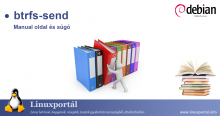Content
Data
license:
Version:
Developer / owner:
Short description:
Manual page and help for the btrfs-send linux command. The command generates a series of instructions that describe the changes between the snapshots of the two btrfs sub-volumes. The generated stream can be used with the btrfs receive command to copy the sent file system snapshot to another file system. The command works in two modes: full and incremental.
Man page output
man btrfs-sendBTRFS-SEND(8) Btrfs Manual BTRFS-SEND(8)
NAME
btrfs-send - generate a stream of changes between two subvolume snapshots
SYNOPSIS
btrfs send [-ve] [-p <parent>] [-c <clone-src>] [-f <outfile>] <subvol>
[<subvol>...]
DESCRIPTION
This command will generate a stream of instructions that describe changes
between two subvolume snapshots. The stream can be consumed by the btrfs receive
command to replicate the sent snapshot on a different filesystem. The command
operates in two modes: full and incremental.
All snapshots involved in one send command must be read-only, and this status
cannot be changed as long as there’s a running send operation that uses the
snapshot.
In the full mode, the entire snapshot data and metadata will end up in the
stream.
In the incremental mode (options -p and -c), previously sent snapshots that are
available on both the sending and receiving side can be used to reduce the
amount of information that has to be sent to reconstruct the sent snapshot on a
different filesystem.
The -p <parent> option can be omitted when -c <clone-src> options are given, in
which case btrfs send will determine a suitable parent from among the clone
sources.
You must not specify clone sources unless you guarantee that these snapshots are
exactly in the same state on both sides—both for the sender and the receiver.
Options
-e
if sending multiple subvolumes at once, use the new format and omit the end
cmd marker in the stream separating the subvolumes
-p <parent>
send an incremental stream from parent to subvol
-c <clone-src>
use this snapshot as a clone source for an incremental send (multiple
allowed)
-f <outfile>
output is normally written to standard output so it can be, for example,
piped to btrfs receive. Use this option to write it to a file instead.
--no-data
send in NO_FILE_DATA mode
The output stream does not contain any file data and thus cannot be used to
transfer changes. This mode is faster and is useful to show the differences
in metadata.
-v|--verbose
enable verbose output, print generated commands in a readable form, (each
occurrence of this option increases the verbosity level)
-q|--quiet
suppress all messages except errors
EXIT STATUS
btrfs send returns a zero exit status if it succeeds. Non zero is returned in
case of failure.
AVAILABILITY
btrfs is part of btrfs-progs. Please refer to the btrfs wiki
http://btrfs.wiki.kernel.org for further details.
SEE ALSO
mkfs.btrfs(8), btrfs-receive(8)
Btrfs v4.20.1 01/23/2019 BTRFS-SEND(8)
Help output
sudo btrfs sendusage: btrfs send [-ve] [-p <parent>] [-c <clone-src>] [-f <outfile>] <subvol> [<subvol>...]
Send the subvolume(s) to stdout.
Sends the subvolume(s) specified by <subvol> to stdout.
<subvol> should be read-only here.
By default, this will send the whole subvolume. To do an incremental
send, use '-p <parent>'. If you want to allow btrfs to clone from
any additional local snapshots, use '-c <clone-src>' (multiple times
where applicable). You must not specify clone sources unless you
guarantee that these snapshots are exactly in the same state on both
sides, the sender and the receiver. It is allowed to omit the
'-p <parent>' option when '-c <clone-src>' options are given, in
which case 'btrfs send' will determine a suitable parent among the
clone sources itself.
-e If sending multiple subvols at once, use the new
format and omit the end-cmd between the subvols.
-p <parent> Send an incremental stream from <parent> to
<subvol>.
-c <clone-src> Use this snapshot as a clone source for an
incremental send (multiple allowed)
-f <outfile> Output is normally written to stdout. To write to
a file, use this option. An alternative would be to
use pipes.
--no-data send in NO_FILE_DATA mode, Note: the output stream
does not contain any file data and thus cannot be used
to transfer changes. This mode is faster and useful to
show the differences in metadata.
-v|--verbose enable verbose output to stderr, each occurrence of
this option increases verbosity
-q|--quiet suppress all messages, except errors
Related Content
- Manual page - btrfs
- Manual page - btrfs-balance
- Manual page - btrfs-check
- Manual page - btrfs-convert
- Manual page - btrfs-device
- Manual page - btrfs-filesystem
- Manual page - btrfs-find-root
- Manual page - btrfs-image
- Manual page - btrfs-inspect-internal
- Manual page - btrfs-map-logical
- Manual page - btrfs-property
- Manual page - btrfs-qgroup
- Manual page - btrfs-quota
- Manual page - btrfs-receive
- Manual page - btrfs-replace
- Manual page - btrfs-rescue
- Manual page - btrfs-restore
- Manual page - btrfs-scrub
- Manual page - btrfs-select-super
- Manual page - btrfs-subvolume
- Manual page - btrfstune
- Manual Page - mkfs.btrfs
- 16 views

